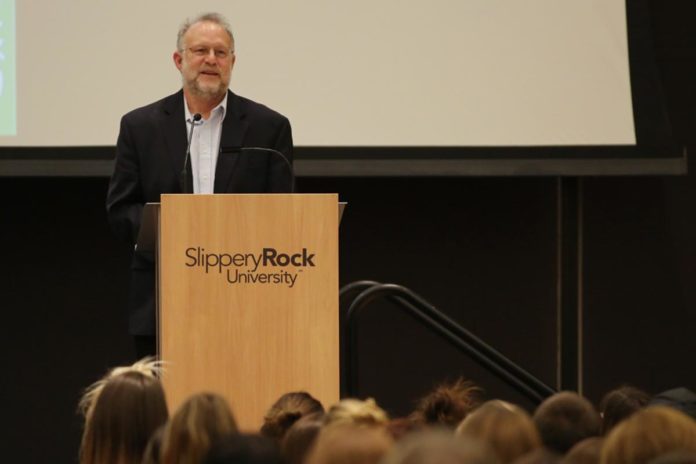At 13 years old and in their local gym class, the two “fattest, slowest” students running the track would become best friends and the future co-founders of Ben & Jerry’s. Jerry Greenfield knew that he would become friends with Ben Cohen when he heard Cohen exclaim, “Gee coach if I couldn’t run the mile in under seven minutes the first time, I’m certainly not going to run it in under seven minutes the second time!” after having a coach push him to run a mile in under seven minutes.
Greenfield introduced the company’s history, how they became a nationally recognized brand and the importance of social justice in business when he addressed students as part of the University Program Board’s (UPB) event at Slippery Rock University Tuesday in the ballroom of the Robert M. Smith Student Center.
After a series of odd jobs, failures and a $5 correspondence course at Penn State University, the duo was ready to enter the ice cream business.
“We started in Vermont because we began with a homemade ice cream parlor, we wanted to find a place with no other ice cream parlor,” he said.
Greenfield said that everywhere that was warm already had an ice cream parlor. He was fine with having a place that had no competition because he “had no idea what he was doing.”
“We didn’t have a lot going for us,” Greenfield admitted.
The company became a spotlight of national news after Haagan-Dazs, which had been recently purchased by Pillsbury at the time, was threatening to stop allowing businesses to sell their ice cream if they sold Ben & Jerry’s.
The company went after what Greenfield described as “the most beloved mascot of any food mascot in America” and he began the “What’s the Doughboy afraid of” campaign with a one-man picket line, protesting the injustice Ben & Jerry’s was experiencing. Eventually the campaign exploded with national attention and a win for the small business, Haagan-Dazs agreed to stop trying to hinder distribution of Ben & Jerry’s. In time, the ice cream was sold across the country.
GETTING A SCOOP OF THE ACTION
Against the advice of their business advisors, the two men sold public stock in the company in an effort to avoid traditional business growth and maintain their ethical views and values.
“Normally public offerings are reserved for so called sophisticated investors that have several thousand dollars. That’s not what we were looking for. We were looking for our neighbors. We advertised it in the first section of the newspaper right next to the clothing ads and the supermarket ads,” Greenfield said.
With a $126 minimum purchase, one of every 100 families in Vermont became owners of the company. Later, national stock was sold with the promise of the Ben & Jerry’s foundation, a charitable group aimed at giving back to the community.
BETTERING THE WORLD WITH BROWNIES
With the foundation in place, Ben & Jerry’s worked to integrate social and environmental concerns into the business in addition to the foundation.
One way this was addressed was through purchase of brownies from Greyston Bakery. The bakery has an open door hiring policy, and, according to Ben & Jerry’s website, “anyone that comes through the front door of the bakery is given the chance to work, regardless of educational attainment, work history or past social barriers, such as incarceration, homelessness or drug use.”
“Simply by purchasing those brownies from Greyston, we’re able to support the work that they do,” Greenfield said. He added that last year the company purchased more than $8 million worth of brownies from Greyston. Ben & Jerry’s recently decided to follow a 100% fair trade agreement. There are also no genetically modified organisms in their products.
“I think it’s important for any company to be not just looking out for making as much money as you can but to be looking out for the general welfare,” Greenfield said. “Ben & Jerry’s happens to be interested in social justice, but business is really the most powerful force in our country and it’s not sufficient for businesses to say our purpose is to make money.” Solving social and environmental problems is an issue for businesses as much as it is on the hands of an individual, according to Greenfield.
“We’re never going to solve social and environmental problems unless business lends a hand also, ” he said.
Criticized by the media for “cynically trying to manipulate customers into buying more ice cream by doing good deeds,” Greenfield defended that “our actions are based on deeply held values.” He said that this philosophy is one that provides great benefit to the company.
“It provides added value to the company. It’s a unique selling proposition that helps with recruiting employees; it helps with retaining employees; and best of all it helps with customers,” he said.
“As we help others, we can’t help but being helped in return,” Greenfield said. “For business and people, it’s all exactly the same.”
“MANY ARE COLD, FEW ARE FROZEN”
“Most new flavors don’t make it,” Greenfield said. He later added that some of both his and Ben’s favorite flavors were retired because they failed to sell. There is a flavor graveyard with all the old flavors on the company’s website, but where do the flavors come from?
“In the old days, Ben used to come up with all the flavors,” Greenfield said. Flavors including Cherry Garcia and Chunky Monkey were customer suggestions, and The Tonight Dough was inspired by a Jimmy Fallon skit. He said that when public figures are selected for featuring they often have some influence on the flavor.
“We want them to like the flavor,” Greenfield said.
UPB members served Cherry Garcia, Chocolate Chip Cookie Dough, Chocolate Fudge Brownie and Americone Dream flavors to those in attendance following Greenfield’s presentation.







